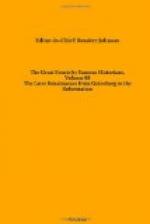From 1354, when Suleiman crossed the Hellespont and captured Gallipoli, the Turks from Asia Minor had kept their foothold on European soil. Under Amurath I (1359-1389), Bajazet I (1389-1403), Mahomet I and Amurath II (1404-1451)—the last of whom, in 1422, unsuccessfully besieged Constantinople—the Ottoman dominions in Europe were much extended. When Mahomet II, son of Amurath II, became Sultan (1451), the Turks were so strongly established, and the Eastern Empire was so much weakened, that he was prepared to finish the work of his predecessors and make the Ottoman power in Europe what it has ever since been.
Mahomet “the Conqueror”—such was his surname—had for his adversary Constantine XIII, the last of the Greek emperors, who was proclaimed in 1448, with the consent of Amurath II, whose power is thus attested. The Empire was torn by the quarrels of political factions and by theological dissensions. When Mahomet succeeded to the sultanate he was but twenty-one years old, but had already given proof of great talents, learning, and ambition, all guided by a judgment of remarkable maturity.
The first object of Mahomet’s ambition was the conquest of Constantinople, the natural capital of his dominions. As long as it was held by Eastern Christians the Ottoman empire was open to invasion by those of the West. The first threatening act of Mahomet was the construction of a fortress on Constantine’s territory, at the narrowest part of the Bosporus, and within five miles of Constantinople. Constantine was too weak to resent the menace with vigor, and Mahomet treated his mild protest with contempt, denying the right of a vassal of the Porte to dispute the Sultan’s will. A feeble resistance by some of the Greeks only gave Mahomet pretexts for further aggression, soon followed by his formal declaration of war.
Both parties began to prepare for the mortal contest. The siege of Constantinople was to be the great event of the coming year. The Sultan, in order to prevent the Emperor’s brothers in the Peloponnesus from sending any succors to the capital, ordered Turakhan, the Pacha of Thessaly, to invade the peninsula. He himself took up his residence at Adrianople, to collect warlike stores and siege artillery. Constantine, on his part, made every preparation in his power for a vigorous defence. He formed large magazines of provisions, collected military stores, and enrolled all the soldiers he could muster among the Greek population of Constantinople. But the inhabitants of that city were either unable or unwilling to furnish recruits in proportion to their numbers. Bred up in peaceful occupation, they probably possessed neither the activity nor the habitual exercise which was required to move with ease under the weight of armor then in use. So few were found disposed to fight for their country that not more than six thousand Greek troops appeared under arms during the whole siege.




